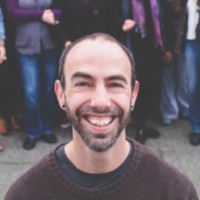I’ve made an amazing discovery and I want to share it with the world!
Actually, it’s not a discovery at all—I learned it from my yoga teacher.
I was in class with my most beloved Yoga teacher, Richard Freeman, at the Yoga Workshop in Boulder, Colorado. We were practicing uttansana, the basic forward bend.
At the time, I thought of myself as an inflexible person, because in a forward bend, I could barely touch my toes.
So there I was, reaching as deeply into the pose as I could tolerate, feeling the burn in my hamstrings as usual, and then, for some strange reason, I decided to pay attention to what Richard was really doing.
He does this thing in uttanasana where he puts his palms flat on the ground with his chest touching his knees, and then he lifts his feet up off of the ground an inch or so. Hovering there, balanced on just his hands, he looks up at us with a smile on his face, and in his beautiful, soft, resonant voice he says, “And breathe.”
It’s a joke. Whenever he does it, we laugh.
It’s a joke because he does this amazing difficult thing that none of us can do, and he does it with such softness and grace that he can smile and speak gently while he’s doing it. In contrast, we’re bent over, red-faced and breathing like women in labor.
He’s making fun of us in a most delightful way.
Like any normal person, I figured that I was tight, and that slowly I would stretch out my muscles and tendons. To some extent, I’d seen evidence that it was working. I could certainly fold further into a forward bend than I had been able to when I’d started practicing Yoga. And all around me I saw more advanced practitioners who were much more flexible because of their practice.
It was perfectly rational of me to think of increasing flexibility as a gradual, slightly painful process.
But then one ordinary day, in the middle of an ordinarily painful forward bend, I realized that I was not listening to my teacher at all. He would show me how to do the poses, and then I’d mimic him to the best of my ability. He could do them better than I because he had a lot more experience.
The fact that I was in pain and he wasn’t didn’t strike me as important—until it did.
There he was, smiling and joking in uttanasana, and I started thinking: He’s not pushing himself at all. He’s not doing anything to make himself uncomfortable. But I am. So I’m not doing what he’s doing. But I could…
In that moment, I stopped pushing, and everything changed. Immediately, I softened everywhere, and my body folded gently and easily.
I no longer felt the burning stretch in my hamstrings, yet my chest was resting softly on my knees, and my hands hung heavily on the floor.
It was a sudden, dramatic change in my so-called flexibility, and it made me question my basic conception of what flexibility is. According to my original idea, flexibility was gained by slowly stretching out the tissue. But according to my experience, I had instantaneously become much more flexible—a feat that would be impossible if gradual stretching of the tissue was the mechanism at work.
I had not stretched myself out: I had let go.
In other words, I had stopped fighting myself.
Now, every time I feel a painful, burning stretch, I know that I am doing something wrong.
My pain tells me that I’m not doing Yoga anymore. I investigate inside myself to find the mental and physical attitudes that are causing me to unnecessarily push against myself, into pain.
Through my investigation, I find grasping, controlling, and fearing to be at the root of every painful stretch. Transformed from the hard work of painfully pushing myself in directions I’m not ready to go, for me doing Yoga has become a gentle, pleasant process of letting go of the grasping and fearing attitudes that lock down my body in self-limiting ways.
Author: Tobin Rangdrol
Editor: Renée Picard
Image: elephant archives












Read 16 comments and reply